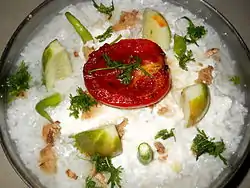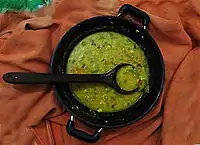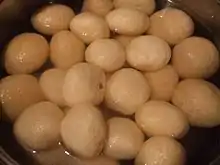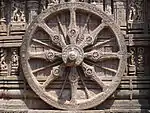Cuisine of Odisha
Odia Cuisine is the cuisine of the state of Odisha. It has developed over time with local culture and agriculture and hence has its distinct items and practices. Odisha borders both north Indian states and south Indian states and consequently is similar to the cuisines of South and North India. [1]

| This article is part of a series on |
| Odisha |
|---|
 |
| Governance |
|
| Topics |
|
Districts Divisions |
| GI Products |
|
|
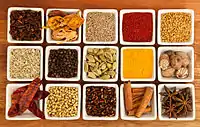 |
| This article is part of the series on |
| Indian cuisine |
|---|
|
Compared to other regional Indian cuisines, Odia cuisine uses less oil and is less spicy while nonetheless remaining flavourful.[2][3] Rice is the staple food of this region. Mustard oil is used in some dishes as the cooking medium, but ghee (made of cow's milk) is preferred in temples.[3] In old times food was traditionally served on banana leaves or disposable plates made of sal leaves.[4]
Odia cooks, particularly from the Puri region, were much sought after due to their ability to cook food in accordance with Hindu scriptures. During the 19th century, many Odia cooks were employed in Bengal and they took many Odia dishes with them.[5] This period also saw a heavy demand for Brahmin cooks, leading many Odia cooks to fake their castes.[6]
Yoghurt is used in dishes. Many sweets of the region are based on chhena (cheese).[7]
Ingredients and seasoning
Rice is a major crop of Odisha, bhumin is the best.[8] Lentils such as pigeon peas and moong beans are another major ingredients.
Indigenous vegetables used in Odia cuisine are Pumpkin, Gourd , plantains, jackfruit, and papaya. Vegetables such as chilies, potatoes, cauliflowers, and cabbages are also used alongside local vegetables.
The curries are garnished with dried raw mango (ambula).[9]
Panchaw phutana is a blend of five spices that is widely used in Odia cuisine. It contains mustard, cumin, fenugreek, aniseed and kalonji(onion seeds). Garlic, onion and ginger are used in most of the food. Temple food preparation doesn't allow the use of garlic or onion. Turmeric and red chillies are used regularly[3]
Local variation
The food in the region around Puri-Cuttack is greatly influenced by the Jagannath Temple. On the other hand, kalonji and mustard paste are used mostly in the region bordering Bengal and curries tend to be sweeter. In the region closer to Andhra Pradesh, curry tree leaves and tamarind are used more. The Brahmapur region has influences of South Indian cuisine and the Telugu people living there have invented new Odia dishes.[10]
Temple food
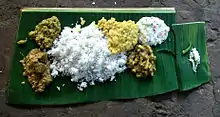
Temples in the region make offerings to the presiding deities. The prasada of the Jagannath Temple is well known and is specifically called Maha Prasad meaning greatest of all prasadas. It consists of 56 recipes, so it is called chhapan bhoga. It is based on the legend that Krishna missed his eight meals for seven days while trying to save a village from a storm holding up the Govardhan hill as a shelter.[7]
Fish and seafood
Fish and other seafoods are eaten mainly in coastal areas. Several curries are prepared from prawn and lobster with spices.[3][11] Freshwater fish is available from rivers and irrigation canals.[5] Rohu, Catla and Ilishi are the famous freshwater fishes used in curries.
List of dishes
Rice dishes and rotis
- Pakhala is a rice dish made by adding water with curd to cooked rice. It may then be allowed to ferment overnight. This is called basi pakhala and dahi pakhala. The unfermented version of this is called saja pakhala. It is served with green chillies, onions, yoghurt, badi etc. It is primarily eaten in summer.[12][13]
- Khechidi is a rice dish cooked with lentils.[14][15] It is the Odia version of khichdi.[16]
- Palau is a rice dish made from meat, vegetables and raisins. It is the Odia version of pilaf.[17][18]
- Kanika is a sweet rice dish, garnished with raisins and nuts.[13][19]
- Ghee rice is fried with ghee and cinnamon
Dal
- Dalma: A dish made from dal and vegetables.[20] It is generally made from toor dal and contains chopped vegetables like green papaya, unripe banana, eggplant, pumpkin, gourd, etc. It is garnished with turmeric, mustard seeds, and panch phutana. There are several variations of this dish.[5]
- Dali: A dish made from one of the Dals like tur, Kolatha(horse gram) dali chana, masur, mung or a combination of these.
Curries
Odia cooking has some different type of curries based on the overall preparation style. Tarakari, Santula, Rai, Rasa.
- Santula: A dish of finely chopped vegetables which are sauteed with garlic, green chilies, mustard and spices. It has several variations.[5][13]
- Chaatu rai: A dish made from mushrooms and mustard.[20]
- Alu potala rasa: Curry made from potato and parval.[14]
- Kadali manja rai: A curry made from banana plant stem and mustard seeds. Manja refers to the stem which can be used in dalma.[13][21][22]
- Mahura
- Besara: Assorted vegetables in mustard paste tempered with panch phutana
Khattas and chutneys
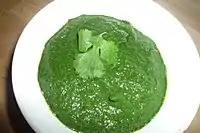
Khatta refers to a type of sour side dish or chutney usually served with Odia thalis.[23]
- Dahi baigana: A sour dish made from yoghurt and eggplants.[13][17]
- Dahi bhendi: A sour dish made from yoghurt and ladies fingers.
- Khajuri khata: A sweet-and-sour dish made from tomato and dates.[13][24][25]
- Amba khatta: A khatta made from raw mangoes.[26]
- Ouu khatta: Elephant apple khatta[5]
- Tomato khata: A sweet-and-sour dish made from tomato and jaggery
- Dhania-patra chutney: A chutney made from coriander leaves.[27]
Saaga (salad greens)
In Odia cuisine, sāga is one of the most important vegetables. It is popular all over the state. A list of the plants that are used as sāga is as below. Odias typically eat many cooked green leaves. They are prepared by adding "pancha phutana", with or without onion/garlic, and are best enjoyed with pakhala.
- Kalama sāga (କଳମ ଶାଗ) Ipomoea aquatica (Water Spinach)
- Kosalā/Khadā sāga (କୋସଳା ଶାଗ/ଖଡା ଶାଗ): prepared from amaranth leaves.
- Bajji sāga (ବଜ୍ଜୀ ଶାଗ): Prepared from Amaranthus dubius leaves.
- Leutiā sāga (ଲେଉଟିଆ ଶାଗ)Amaranthus viridis leaves and tender stems.
- Pālanga sāga (ପାଳଙ୍ଗ ଶାଗ) spinach
- Poi sāga (ପୋଈ ଶାଗ): prepared from basella leaves and tender stems.
- Bāramāsi/Sajanā sāga (ବାରମାସି/ ସଜନା ଶାଗ): prepared from leaves of the drumstick tree. Cooked with lentils or alone with fried onions.
- Sunusuniā sāga (ସୁନୁସୁନିଆ ଶାଗ) Marsilea polycarpa leaves.
- Pitāgama sāga (ପିତାଗମା ଶାଗ)
- Pidanga sāga (ପିଡଙ୍ଗ ଶାଗ)
- Kakhāru sāga (କଖାରୁ ଶାଗ): Prepared from leaves of the pumpkin plant.
- Madarangā sāga (ମଦରଙ୍ଗା ଶାଗ): prepared from leaves of Alternanthera sessilis.
- Sorisa saga (ଶୋରିସ ଶାଗ) : Mustard greens
- Methi sāga (ମେଥୀ ଶାଗ): prepared from methi or Fenugreek leaves and besara (mustard paste) cooked with vegetable.[28]
- Matara sāga (ମଟର ଶାଗ): The inner coating of peas is removed and then chopped to make the saga.
One of the most popular is lali koshala saaga made from green leaves with red stems. Other saagas that are eaten are pita gahama, khada, poi, koshala, and sajana. Some items are as follows:
Pithas (sweet cakes)
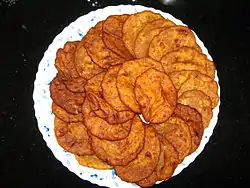

Pithas and sweets are types of traditional Odia dishes.[29][30]
- Podo pitha
- Enduri Pitha
- Arisa Pitha
- Kakara Pitha
- Manda Pitha
- Chakuli Pitha
- Tal Pitha
- Ruka Pitha
- Chitau Pitha
- Janta Pitha eaten during fever,
- Parijata Pitha
- Nurukhurum Pitha
- Chandrakanti
- Chhunchi Patra Pitha
- Goitha goli Pitha
- Haldi Patra Pitha
- Lau Pitha
- Muan
Egg, chicken and mutton
- Anda tarkari: An egg curry prepared with onion and tomato paste
- Chicken tarkari: A chicken curry
- Chicken kasa
- Saru Patra Poda Chicken
- Mangsaw tarkari
- Mangsaw kasa
- Mangsaw besara
- Baunsaw Poda Mangsaw
- Patra Poda Mangsaw
- Mati Handi Mangsaw
Fish and other sea food

- Machha Besara: A fish curry prepared with mustard paste.[13][31]
- Machha Mahura: A curry prepared with fish and vegetables.[13][32]
- Machha Jhola
- Chingudi Jhola
- Dahi machha
- Machha chhencheda
- Chunna Machha Jhola: A fish curry, similar to Machha Jhola, but prepared with small smelt fish.
- Chunna Machha Tarkari: Small fried smelt fishes[14]
- Chingudi Malai Tarkari: A prawn curry[14]
- Kankada Jhola: Crab curry[14]
- Chingudi chadchadi
- Kokali sukhua rai[33]
- Mullet curry(ଖଅଙ୍ଗା ମାଛ ତରକାରୀ )
- Milkfish Curry ( ସେବା ଖଙ୍ଗା ମାଛ ତରକାରୀ )
- smoked oil sardine(dryfish) with garlic- କୋକଲି ଶୁଖୁଆ ସେକା /ପୋଡା
Smoked Dry sardine after cleaning mix with garlic,green chilly, salt using moter & pistel or mixture grinder. Dry White bait fish (ଚାଉଳି ଶୁଖୁଆ ), dry shrimp (ଚିଙ୍ଗୁଡ଼ି ଶୁଖୁଆ, ତାଂପେଡା ) etc also prepared like this Flake/powdered.
- seer fish (କଣି ମାଛ )/ mackeral(କାନାଗୁର୍ତ୍ଆ, ମରୁଆ) curry, chilly
- Bitter dry fish fry (ପିତା ଶୁଖୁଆ ଭଜା )- small freshwater nutrient fish dried in sun ray in hygienic manner and eaten fried or smocked.
- ପୋହଳା ମାଛ ତରକାରୀ ( minor /small carp fish curry). Great taste and nutrious.
- Mola fry/ chips/ boild grind. ମହୁରାଳୀ ମାଛ ଭଜା / ଛଣା / ଚକଟା. Very nutriuos. After Clean wash, boil in less water added salt and turmeric. Mix with mustard oil, green chilly, garlic, onion and grind. Taste the nutrition best.
Fritters and fries
- Alloo piaji:[34] A savory snack, similar to pakora or fritters, made with potatoes and onions, long-sliced, mixed and dipped in a batter of gram-flour, and then deep-fried
- Bhendi baigana bhaja:[14] okra (ladies' fingers) and eggplant, sliced and deep-fried
- Badi Chura:[35] A coarse crushed mixture of sun-dried lentil dumplings (Badi), onion, garlic, green chillies and mustard oil
- Pampad : flat savory snack like deep-friend or roasted appetizer, which looks very similar to a roti, usually eaten during lunch time
- Phula badi: Bigger and inflated versions of the normal Badi - a sun-dried lentil dumpling
- Sajana Chhuin Bhaja: Drumsticks sliced into 3 to 3 inch long pieces and deep/shallow fried in oil
- Desi Kankada bhaja(ଦେଶୀ କାଙ୍କଡ଼ ଭଜା )- A vegetable found in hilly area and fried with oil, onion drird chilli flake, cumin powder
- country potato fry(ଦେଶି ଆଳୁ/ଖମ୍ବ ଆଳୁ ଭଜା )- first slice into small pieces and half boil it with turmeric and salt. Then fry using oil in high flame. Add fried and powdered mustard, cumin red chilli to taste.
- Banana fry(କଞ୍ଚା କଦଳୀ ଭଜା )- As country potato fry
- Bamboo stem(ବାଉଁଶ କରଡି ) recipe - usually done by people of hilli area/ Tribal people in dried form (ହେଂଡୁଅ)for flavour or raw as curry, fry, chips.
- ନଡ଼ିଆ ବରା coconut vada
- ପିଠଉ ଦିଆ ଭଜା (Fry with rice and urad dal mix batter)- different Vegetable/ vegetables slice with rice batter (added cumin, salt, dalcchini, ginger, garlic, onion, green chilli paste)
For example- jack fruit pithau fry, Brinjal pithau fry, Gourd pithau fry, Kaddu/kakharu flower pithou fry Etc.
Snacks
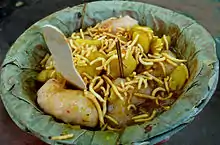
- Ghugni: A spicy dish made from peas, can be served with pooris.[34][36]
- Gupchup[37]
- Chaat
- Dahibara Aludam
- Chanachura or Baramaza
- Piaji
- Bara
- Gulgula
- Chuda (Poha) Bhaja
- Chuda (Poha) Dahi as breakfast
- Mudhi (Mur mura) as breakfast or evening snacks
- Khai
- Chauhla bhaja
- Checha Piaji
- Kachodi chaat
- Suji Bara
- Pakudi
- Aloo chop
- Baigani
- Dantikili
- Singada
Desserts and sweets
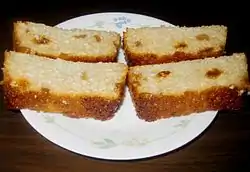
- Kheeri: Kheeri is the Odia word for kheer, predominantly made of rice.[15][38]
- Chhena Poda: A sweet made from soft cheese dipped in sugar syrup and baked. It may contain dry fruits.[3]
- Chhena Gaja[26]
- Malpua[34]
- Kora[5]
- Khira sagara[34]
- Khirsapani
- Chhena kheeri
- Suji kheeri
- Chhena Jhili[14][23]
- Rasagola
- Rasabali[14][23]
- Rasmalai[39]
- Aadasi
- Attakali[40]
- Khaja
- Magaj Ladu
- Gajja : a light savory snack
- Rabidi : a sweet curd like dish
- Mudki: A famous savory snack which resembles a jalebi but the only difference being that jalebi are on the sweet palette where as mudki are light and more savoury
- Chenna Mudki
Drinks
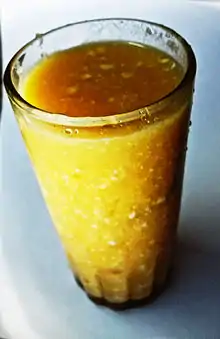
There are many traditional alcoholic and non-alcoholic drinks which are unique to Odisha. Some are made during specific festivals or as an offering to gods and others are made all year. The drinks which have a thick consistency are usually called pawṇaa (Odia: ପଣା) and the ones with have a watery consistency are usually known as sarbat.[41][42][43] Many of the ethnic tribes[44] of Odisha have their own indigenous drinks made from forest produce. Any drink that contains alcohol is usually called mad (Odia: ମଦ୍) or madaw (Odia: ମଦ).[45][46]
Alcoholic
- Aamba mada - mango-based alcoholic beverage
- Aakhu mada - sugarcane-based alcoholic beverage
- Amrutkumnda mada - papaya-based alcoholic beverage
- Anlaa mada - Indian gooseberry-based alcoholic beverage
- Dumuri tadi - juice of Indian fig-based alcoholic beverage
- Dumuri mada - pulp of Indian fig-based alcoholic beverage
- Handia - traditional rice beer popular among the tribes of Odisha
- Gadli mada - banana-based alcoholic beverage
- Guda mada - sugarcane-based alcoholic beverage
- Jama mada - guava-based alcoholic beverage
- Jamukoli mada - Malabar plum-based alcoholic beverage
- Jana mada - maize-based alcoholic beverage
- Kamala mada - palm-based alcoholic beverage
- Kumuda mada - squash-based alcoholic beverage
- Landa - rice-based alcoholic beverage
- Mahulu mada or mahuli - mahua flower-based alcoholic beverage
- Panas mada - jackfruit-based alcoholic beverage
- Pendum - rice-based alcoholic beverage consumed by the Bonda tribe
- Rasi - a type of rice beer related to handia; popular among the tribes of Odisha [47]
- Sagur - alcoholic beverage made from different fruit nuts, mahua flowers or fruits using the process of distillation known as sagur by the Bonda tribe
- Salapi - palm-based alcoholic beverage
- Sapung - sago palm-based alcoholic beverage consumed by the Bonda tribe
- Sindi mada - date palm-based alcoholic beverage
- Tamati mada - tomato-based alcoholic beverage
- Tetel mada - tamarind-based alcoholic beverage
Cannabis-based
- Bhangaw sarbat or bhangaw pawṇaa - beverage containing a paste of cannabis leaves[48][49]
Non-alcoholic
- Adhara pawṇaa - a milk and chenna-based drink offered to the trinity at the end of Rathaw Jatra
- Ambaw pawṇaa - a mango-based summer drink
- Belaw pawṇaa - a drink made from wood or stone apple during Pawṇaa Sankranti festival
- Dahi pudina sarbat - a summer drink made using curd and mint leaves
- Gholaw dahi - buttermilk with spices
- Landa bagula dahi sarbat - a drink made from curd and sweet basil seeds
- Lembu sarbat - summer drink made from water, lemon, sugar and salt
- Khajuri misri and lembu sarbat - summer drinks made from date palm misri, lemon and sweet basil seeds
- Mandia pejaw - a millet-based summer drink [42]
- Palua or jhara Ppwṇaa - a summer drink made from arrowroot and jaggery in southern Odisha [42][49]
- Tnkaw toraaṇi - a ricewater-based drink prepared in Jagannath Temple
References
- Brien, C.O. (2013). The Penguin Food Guide to India. Penguin Books Limited. ISBN 978-93-5118-575-8. Retrieved 2 December 2019.
- "The coastal edge". The Telegraph (India). 27 March 2010. Retrieved 11 September 2014.
- "From the land of Jagannath". The Hindu. 28 July 2004. Retrieved 11 September 2014.
- "Not a stereotyped holiday". The Hindu. 10 March 2002. Retrieved 11 September 2014.
- Charmaine O' Brien (15 December 2013). "Orissa". The Penguin Food Guide to India. Penguin Books Limited. p. 188. ISBN 978-93-5118-575-8. Retrieved 9 December 2014.
- Utsa Ray (30 November 2014). Culinary Culture in Colonial India. Cambridge University Press. p. 126. ISBN 978-1-107-04281-0.
- Rocky Singh; Mayur Sharma (25 July 2014). Highway on my Plate-II: the Indian guide to roadside eating. Random House India. p. 370. ISBN 978-81-8400-642-1.
- https://archive.india.gov.in/knowindia/state_uts.php?id=77
- Northeast India. Lonely Planet. 2007. p. 86. ISBN 978-1-74179-095-5. Retrieved 9 December 2014.
- "New cookery show on TV soon". The Hindu. 23 December 2010.
- "Inside Delhi". The Hindu. 11 January 2011. Retrieved 11 September 2014.
While savouring Chingudi malai curry (prawns with rich Oriya spices) and kukuda jhola (chicken cooked with spices and egg), the friend soaked in the atmosphere and was transported back to the sight and smell of his native place.
- "Pakhala, a hot favourite in Odisha's summer menu". Zee News. 11 April 2010. Retrieved 9 December 2014.
- "Oriya cuisine spices up syllabus". The Telegraph (India). 23 February 2011. Retrieved 11 September 2014.
- "Yummy fare at Odia food fest". The Hindu. 26 February 2010. Retrieved 11 September 2014.
- "Women vie for kitchen queen title — Contestants cook up mouth-watering dishes at cookery contest". The Telegraph (India). 9 August 2010. Retrieved 11 September 2014.
Oriya dishes like khiri, khichdi, kasha mansa were also prepared by the contestants.
- "Khechidi". Oriya Kitchen. Retrieved 9 December 2014.
- "Potpouri" (The Telegraph (India)). 29 July 2011. Retrieved 11 September 2014.
- "Palau (pulao)". Oriya Kitchen. Retrieved 9 December 2014.
- "Kanika". Destination Orissa. Retrieved 9 December 2014.
- "Rahul savours 'dalma' and 'khir'". The Hindu. 14 May 2008. Retrieved 11 September 2014.
- Bijoylaxmi Hota; Kabita Pattanaik (2007). Healthy Oriya Cuisine. Rupa & Company. p. 29. ISBN 978-81-291-1118-0.
- "Kadali Manja Rai". eOdisha. Retrieved 9 December 2014.
- "Tasty treat of tangy khatta & spicy tadka". The Telegraph (India). 12 August 2010. Retrieved 11 September 2014.
The Odia thali consists of tangy khatta and proceeds further with traditional dishes such as the green and healthy spinach item saga badi.
- "कच्चे आम की रसीली चटनी: अंबा खट्टा". Boldshy (in Hindi). Retrieved 9 December 2014.
- "Recipe: Tomato-khajuri khatta". The Times of India. 1 October 2012. Retrieved 9 December 2014.
- "It's time to pamper your tastebuds". The Telegraph (India). 16 June 2011. Retrieved 11 September 2014.
- "Coriander Chutney". FullOdisha. Retrieved 9 December 2014.
- Lokesh Dash. "Recipes Methi Saga Recipes". OrissaSpider.com. Archived from the original on 15 September 2012. Retrieved 17 February 2018.
- "Poda pithas take the cake". The Telegraph (India). 16 June 2011. Retrieved 11 September 2014.
- "Traditional 'pitha' undergoes a sea change". The Hindu. 14 April 2008. Retrieved 11 September 2014.
- "Machha Besara (A spicy dish of Rohu fish)". Five Tastes. Retrieved 9 December 2014.
- "Machha Mahura (Fish with Mixed Vegetable Curry)". Bewarchi.
- "Traditional Odia Recipe - Kokali Sukhua". odiarecipes.com.
- "Good response to Odiya food festival". The Hindu. 2 April 2012. Retrieved 11 September 2014.
- "Badi chura". Odia Recipes. Retrieved 11 September 2016.
- "Matar Ghugni aur Murmure". Mamta's Kitchen. Retrieved 9 December 2014.
- "Youths from Bihar and UP rule the 'golgappa' market". The Hindu. 13 November 2009. Retrieved 11 September 2014.
- "A cook-off in the lord's name". The Telegraph (India). 19 July 2013. Retrieved 11 September 2014.
- "Several good reasons to loiter". The Hindu. Retrieved 11 September 2014.
Mouth-watering malpua, rasagulla, rasamalei, gulab jamun and other Oriya sweetmeats are served here.
- "Attakali". Odia Recipes. Retrieved 11 September 2016.
- "Pana Pani Katha : Tales of Summer Drink". Medium. 14 April 2018.
- https://odishasuntimes.com/beat-the-heat-in-odisha-with-these-traditional-summer-drinks/
- "10 most popular Drink and Beverage in odisha". 4 September 2019.
- List of Scheduled Tribes in Odisha
- https://www.researchgate.net/publication/316782136_Indigenous_Alcoholic_Beverages_Of_Rayagada_District_Odisha_India
- "Intoxicating Beverages of The Bonda Highlanders". www.etribaltribune.com.
- "The popular adivasi food and drink". www.downtoearth.org.in.
- "Raise a toast to beer the heat - Demand soars as tipplers get high on alcoholic drink". www.telegraphindia.com.
- "Beating The Heat: A Sneak Peek Into Exotic Drinks Of Odisha". outlookindia.com.
Further reading
- Bijoylaxmi Hota; Kabita Pattanaik (2007). Healthy Oriya Cuisine. Rupa & Company. ISBN 978-81-291-1118-0.
- Sujata Patnaik; Ranjita Patnaik (2010). Classic Cooking of Orissa. Allied Publishers. ISBN 978-81-8424-584-4.
- Laxmi Parida (1 April 2003). Purba: Feasts from the East: Oriya Cuisine from Eastern India. iUniverse. ISBN 978-0-595-26749-1.
External links
| Wikimedia Commons has media related to Cuisine of Odisha. |
